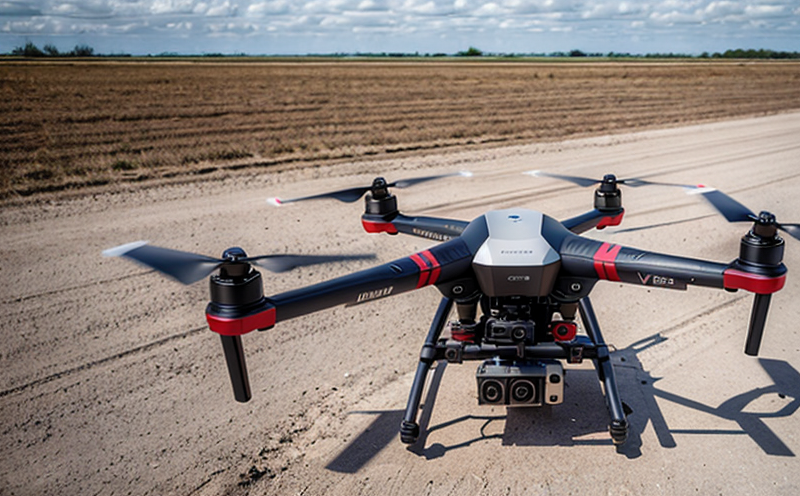ASTM F2910 UAV Design & Construction Testing
The ASTM F2910 standard provides a comprehensive framework to ensure the safety and performance of unmanned aircraft systems (UAS), commonly known as drones. This standard is particularly crucial for those involved in the design, manufacturing, and operation of small UAS used in various industries such as agriculture, surveying, inspection, and surveillance.
The ASTM F2910 covers a wide range of tests including structural integrity, material properties, aerodynamic performance, electrical safety, and environmental testing. Structural integrity is evaluated under static and dynamic conditions to ensure the UAV can withstand expected loads during operation. Material properties are tested to confirm that the materials used in construction meet the required specifications for durability and strength.
Aerodynamic performance tests assess how well the UAV can generate lift, maintain stability, and maneuver effectively. This involves testing at different angles of attack and airspeeds under controlled laboratory conditions. Electrical safety is a critical aspect of UAV design due to the high-voltage systems often used in flight controllers and motors. Tests are conducted to ensure that the system complies with international standards such as IEC 60335-2-84 for household robots and automated machines.
Environmental testing ensures that the UAV can operate under various environmental conditions, including temperature extremes, humidity, and exposure to sunlight. These tests help identify potential weaknesses in design or construction that could impact performance in real-world scenarios. Compliance with ASTM F2910 is essential for manufacturers aiming to meet regulatory requirements set by bodies like the Federal Aviation Administration (FAA) and the European Union Aviation Safety Agency (EASA).
The standard also emphasizes the importance of documentation, which includes detailed records of test procedures, results, and any modifications made during testing. This ensures that all parties involved in the design and manufacturing process have a clear understanding of the UAV's capabilities and limitations.
Compliance with ASTM F2910 is not only crucial for legal reasons but also serves to enhance public trust by demonstrating a commitment to safety and quality. By adhering to this standard, manufacturers can ensure that their products meet international standards and are fit for purpose in various operational environments.
The ASTM F2910 UAV Design & Construction Testing service offered by our laboratory ensures that all aspects of the design and construction process are thoroughly evaluated using state-of-the-art equipment and methodologies. Our team of experts works closely with clients to ensure that every test is conducted accurately and efficiently, providing clear and actionable insights into the performance of the UAV.
Our testing services go beyond mere compliance; they offer a deep understanding of the nuances of UAV design and construction. We provide detailed reports that not only meet regulatory requirements but also highlight areas for improvement and potential enhancements to the UAV's design and materials.
Applied Standards
The ASTM F2910 standard is an integral part of our testing service. This standard specifies test methods for the structural integrity, material properties, aerodynamic performance, electrical safety, and environmental testing of small UAS. The following are some key aspects covered by this standard:
- Structural Integrity: Tests conducted to ensure that UAVs can withstand expected loads during operation.
- Material Properties: Evaluation of the materials used in construction to ensure durability and strength.
- Aerodynamic Performance: Assessment of how well the UAV generates lift, maintains stability, and maneuvers effectively.
- Electrical Safety: Tests ensuring that the system complies with international standards such as IEC 60335-2-84 for household robots and automated machines.
- Environmental Testing: Ensuring UAVs can operate under various environmental conditions, including temperature extremes, humidity, and exposure to sunlight.
Our laboratory strictly adheres to ASTM F2910 standards during testing, providing clients with reliable and consistent results. This ensures that the UAVs tested meet not only regulatory requirements but also exceed industry expectations for safety and performance.
Industry Applications
ASTM F2910 UAV Design & Construction Testing finds application across various industries, including agriculture, surveying, inspection, and surveillance. Here are some key areas where this testing is particularly relevant:
- Agriculture: Ensuring that UAVs used for crop monitoring and spraying can withstand the environmental conditions they encounter.
- Surveying: Testing UAVs to ensure they can operate accurately in various terrains and weather conditions, providing reliable data for mapping and surveying projects.
- Inspection: Evaluating UAVs used for infrastructure inspections such as bridges and buildings to ensure their safety and reliability.
- Surveillance: Ensuring that UAVs can operate effectively in security and defense applications, providing reliable intelligence and surveillance data.
- Research & Development: Supporting the development of new UAV designs by identifying areas for improvement and enhancement.
- Manufacturing: Assisting manufacturers in meeting regulatory requirements and improving product quality and safety.
In addition to these sectors, ASTM F2910 testing is beneficial for any organization involved in the design, manufacturing, or operation of small UAS. This ensures that all parties are aligned with international standards and regulations, enhancing overall safety and performance.
Use Cases and Application Examples
The ASTM F2910 UAV Design & Construction Testing service is used in a variety of scenarios to ensure the reliability and safety of UAVs. Here are some specific use cases:
- Critical Infrastructure Inspection: Ensuring that UAVs can operate safely around sensitive infrastructure such as power plants and refineries.
- Environmental Monitoring: Testing UAVs used for environmental monitoring in remote areas, ensuring they can withstand harsh conditions.
- Hazardous Area Surveillance: Evaluating UAVs designed to monitor hazardous environments where human entry is not feasible or safe.
- Emergency Response: Supporting the development of UAVs that can be used in emergency response scenarios such as search and rescue operations.
- Research & Development: Providing detailed insights into the performance and limitations of new UAV designs, guiding future development efforts.
Each use case requires specific testing parameters, specimen preparation, and instrumentation tailored to the particular application. Our laboratory ensures that all tests are conducted rigorously and accurately, providing reliable data for decision-making and continuous improvement in design and construction.





